Strategic Growth, Funding, and Exit Plan Report for Businesses
VerifiedAdded on 2022/01/24
|76
|20883
|111
Report
AI Summary
This report provides a comprehensive analysis of business growth strategies, exploring key considerations for evaluating growth opportunities and justifying them within an organizational context. It examines various options for growth using analytical frameworks, including the Ansoff matrix, to demonstrate an understanding of competitive advantage. The report critically evaluates specific growth options, considering associated risks and mitigation strategies. It also assesses potential sources of funding, justifying the adoption of appropriate sources based on organizational needs and evaluating the benefits and drawbacks of each. Furthermore, the report includes the design of a detailed business plan for growth, encompassing financial information and strategic objectives for scaling up a business, as well as an evaluation of exit or succession options for small businesses, comparing the options and making recommendations. The analysis incorporates frameworks such as PESTLE analysis and Porter's generic strategies to provide a robust understanding of the business environment and competitive landscape.
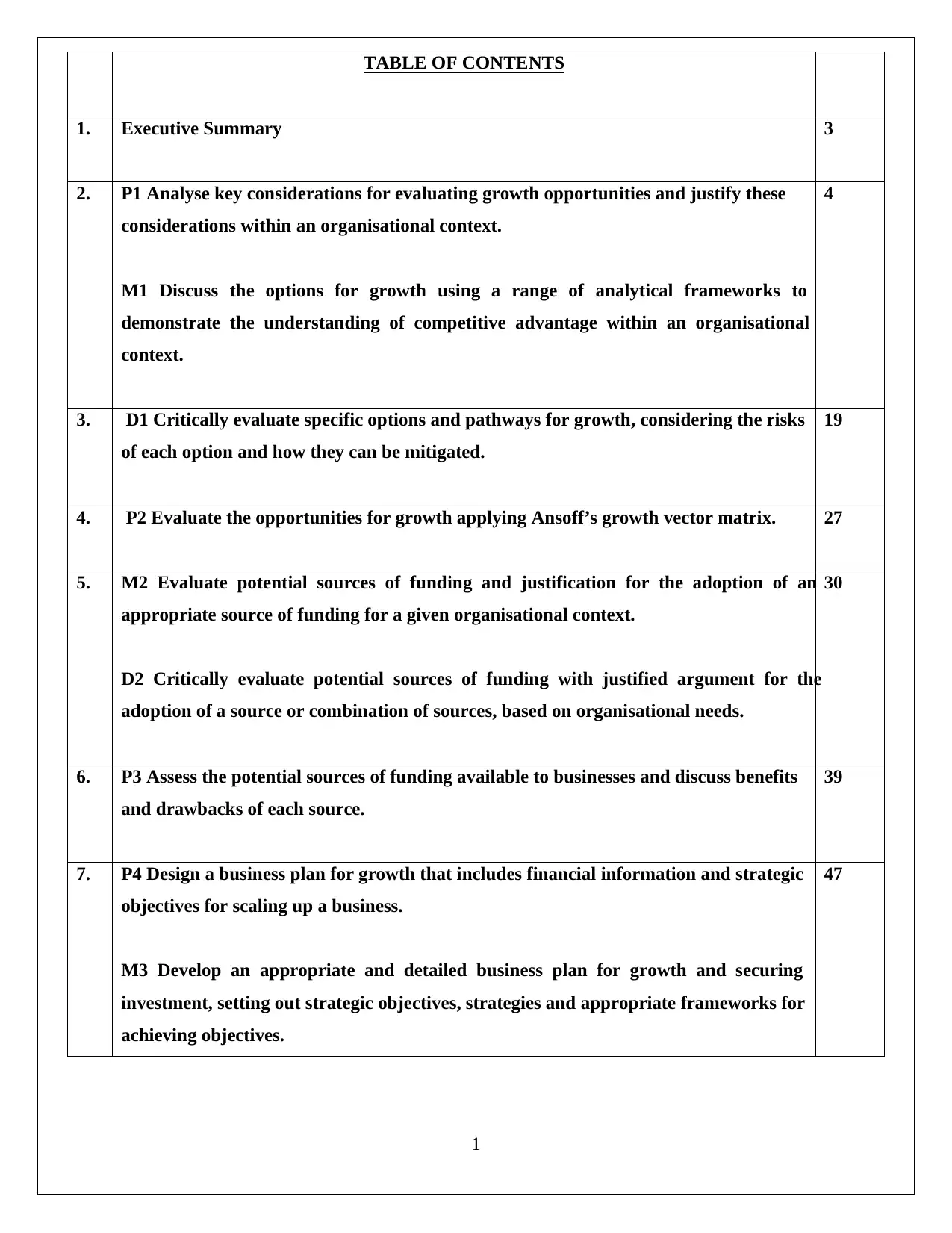
1
TABLE OF CONTENTS
1. Executive Summary 3
2. P1 Analyse key considerations for evaluating growth opportunities and justify these
considerations within an organisational context.
M1 Discuss the options for growth using a range of analytical frameworks to
demonstrate the understanding of competitive advantage within an organisational
context.
4
3. D1 Critically evaluate specific options and pathways for growth, considering the risks
of each option and how they can be mitigated.
19
4. P2 Evaluate the opportunities for growth applying Ansoff’s growth vector matrix. 27
5. M2 Evaluate potential sources of funding and justification for the adoption of an
appropriate source of funding for a given organisational context.
D2 Critically evaluate potential sources of funding with justified argument for the
adoption of a source or combination of sources, based on organisational needs.
30
6. P3 Assess the potential sources of funding available to businesses and discuss benefits
and drawbacks of each source.
39
7. P4 Design a business plan for growth that includes financial information and strategic
objectives for scaling up a business.
M3 Develop an appropriate and detailed business plan for growth and securing
investment, setting out strategic objectives, strategies and appropriate frameworks for
achieving objectives.
47
TABLE OF CONTENTS
1. Executive Summary 3
2. P1 Analyse key considerations for evaluating growth opportunities and justify these
considerations within an organisational context.
M1 Discuss the options for growth using a range of analytical frameworks to
demonstrate the understanding of competitive advantage within an organisational
context.
4
3. D1 Critically evaluate specific options and pathways for growth, considering the risks
of each option and how they can be mitigated.
19
4. P2 Evaluate the opportunities for growth applying Ansoff’s growth vector matrix. 27
5. M2 Evaluate potential sources of funding and justification for the adoption of an
appropriate source of funding for a given organisational context.
D2 Critically evaluate potential sources of funding with justified argument for the
adoption of a source or combination of sources, based on organisational needs.
30
6. P3 Assess the potential sources of funding available to businesses and discuss benefits
and drawbacks of each source.
39
7. P4 Design a business plan for growth that includes financial information and strategic
objectives for scaling up a business.
M3 Develop an appropriate and detailed business plan for growth and securing
investment, setting out strategic objectives, strategies and appropriate frameworks for
achieving objectives.
47
Paraphrase This Document
Need a fresh take? Get an instant paraphrase of this document with our AI Paraphraser
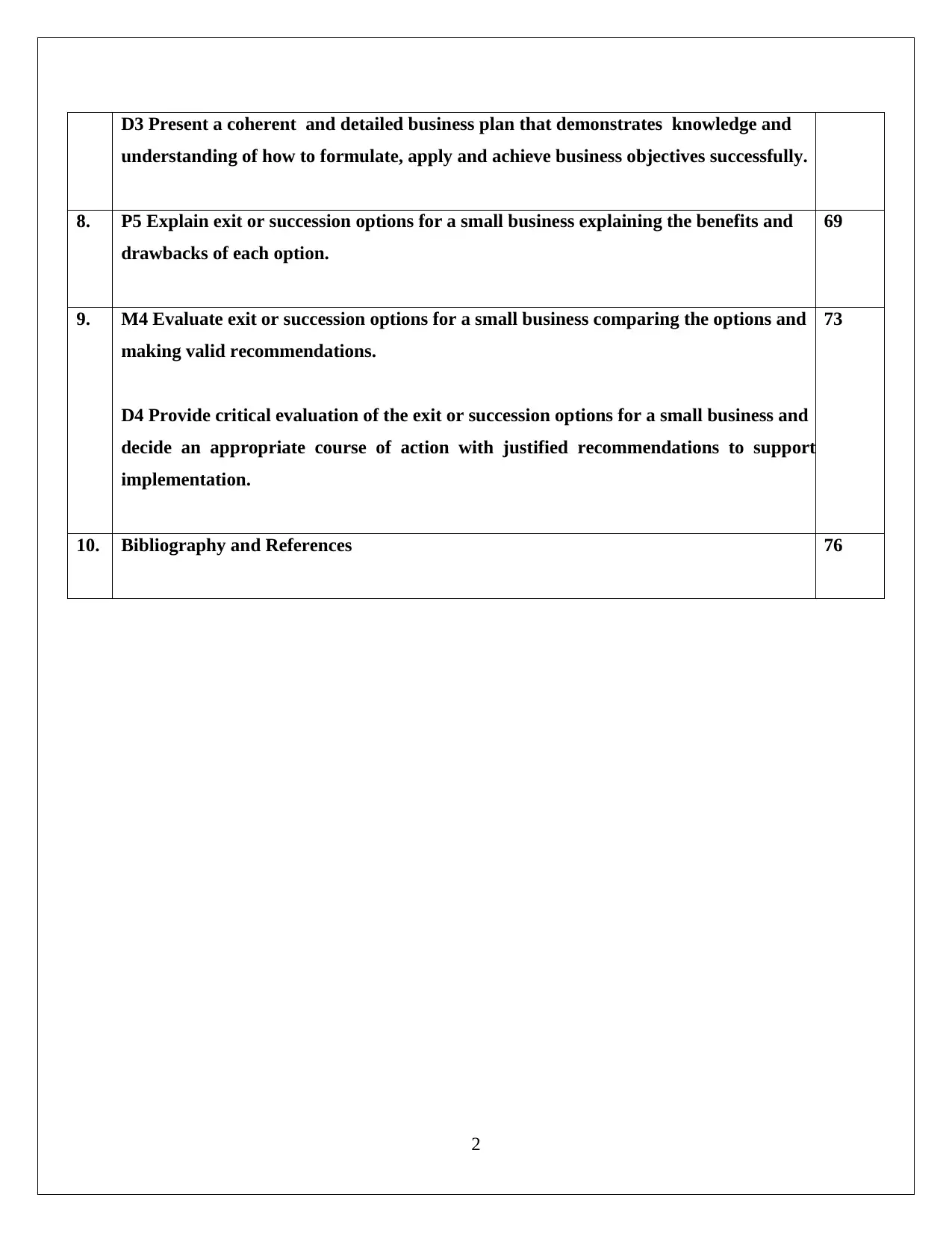
2
D3 Present a coherent and detailed business plan that demonstrates knowledge and
understanding of how to formulate, apply and achieve business objectives successfully.
8. P5 Explain exit or succession options for a small business explaining the benefits and
drawbacks of each option.
69
9. M4 Evaluate exit or succession options for a small business comparing the options and
making valid recommendations.
D4 Provide critical evaluation of the exit or succession options for a small business and
decide an appropriate course of action with justified recommendations to support
implementation.
73
10. Bibliography and References 76
D3 Present a coherent and detailed business plan that demonstrates knowledge and
understanding of how to formulate, apply and achieve business objectives successfully.
8. P5 Explain exit or succession options for a small business explaining the benefits and
drawbacks of each option.
69
9. M4 Evaluate exit or succession options for a small business comparing the options and
making valid recommendations.
D4 Provide critical evaluation of the exit or succession options for a small business and
decide an appropriate course of action with justified recommendations to support
implementation.
73
10. Bibliography and References 76
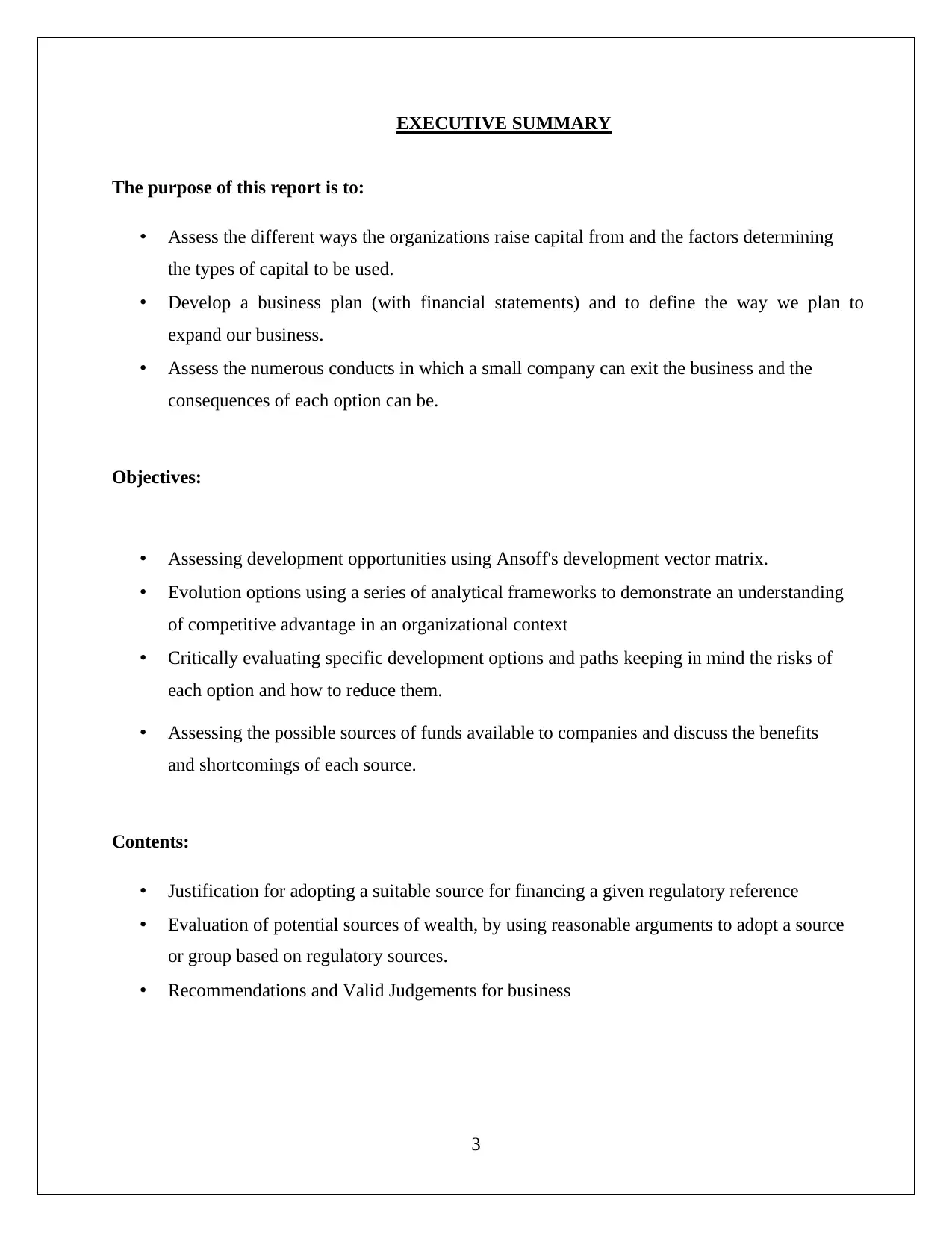
3
EXECUTIVE SUMMARY
The purpose of this report is to:
• Assess the different ways the organizations raise capital from and the factors determining
the types of capital to be used.
• Develop a business plan (with financial statements) and to define the way we plan to
expand our business.
• Assess the numerous conducts in which a small company can exit the business and the
consequences of each option can be.
Objectives:
• Assessing development opportunities using Ansoff's development vector matrix.
• Evolution options using a series of analytical frameworks to demonstrate an understanding
of competitive advantage in an organizational context
• Critically evaluating specific development options and paths keeping in mind the risks of
each option and how to reduce them.
• Assessing the possible sources of funds available to companies and discuss the benefits
and shortcomings of each source.
Contents:
• Justification for adopting a suitable source for financing a given regulatory reference
• Evaluation of potential sources of wealth, by using reasonable arguments to adopt a source
or group based on regulatory sources.
• Recommendations and Valid Judgements for business
EXECUTIVE SUMMARY
The purpose of this report is to:
• Assess the different ways the organizations raise capital from and the factors determining
the types of capital to be used.
• Develop a business plan (with financial statements) and to define the way we plan to
expand our business.
• Assess the numerous conducts in which a small company can exit the business and the
consequences of each option can be.
Objectives:
• Assessing development opportunities using Ansoff's development vector matrix.
• Evolution options using a series of analytical frameworks to demonstrate an understanding
of competitive advantage in an organizational context
• Critically evaluating specific development options and paths keeping in mind the risks of
each option and how to reduce them.
• Assessing the possible sources of funds available to companies and discuss the benefits
and shortcomings of each source.
Contents:
• Justification for adopting a suitable source for financing a given regulatory reference
• Evaluation of potential sources of wealth, by using reasonable arguments to adopt a source
or group based on regulatory sources.
• Recommendations and Valid Judgements for business
⊘ This is a preview!⊘
Do you want full access?
Subscribe today to unlock all pages.

Trusted by 1+ million students worldwide
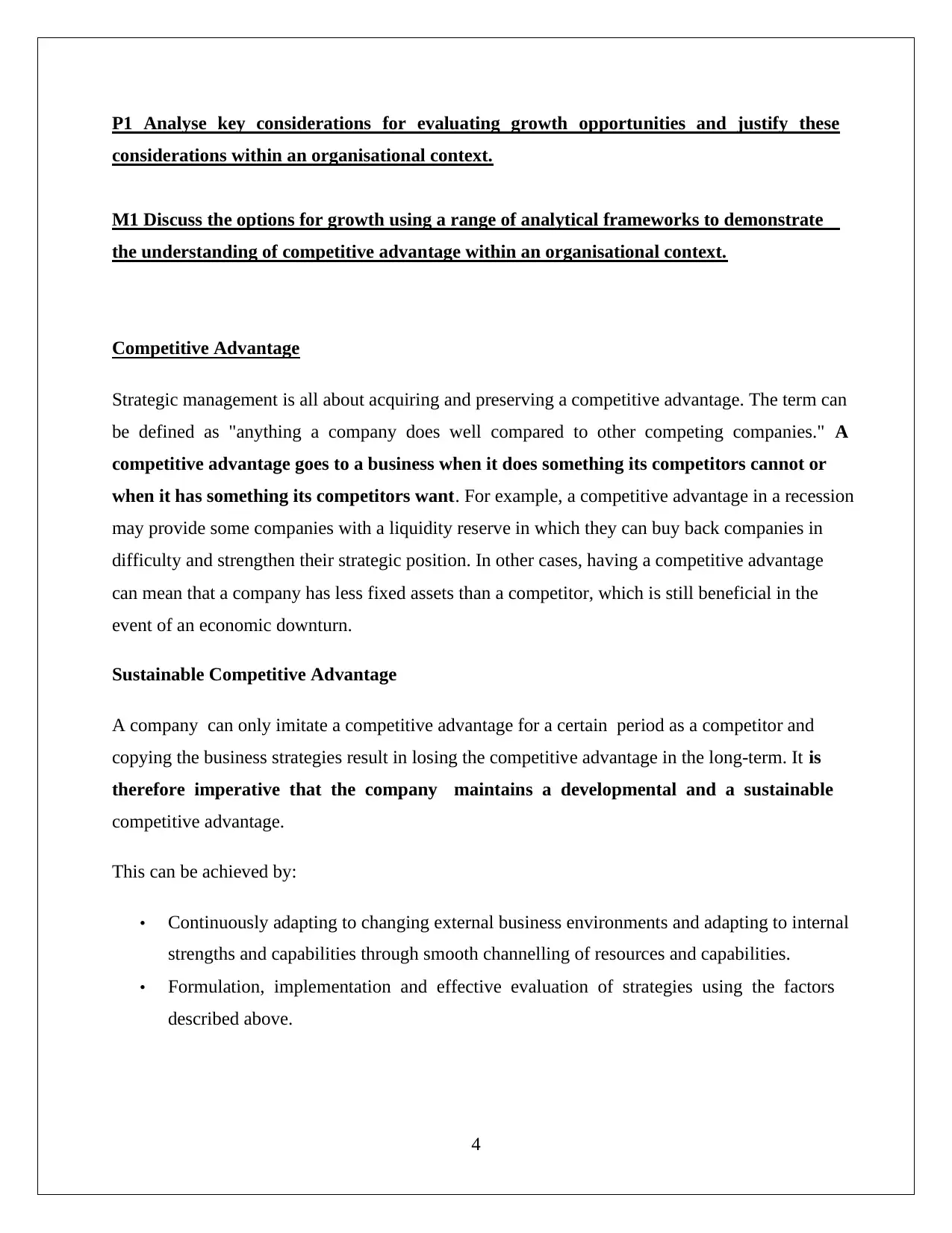
4
P1 Analyse key considerations for evaluating growth opportunities and justify these
considerations within an organisational context.
M1 Discuss the options for growth using a range of analytical frameworks to demonstrate
the understanding of competitive advantage within an organisational context.
Competitive Advantage
Strategic management is all about acquiring and preserving a competitive advantage. The term can
be defined as "anything a company does well compared to other competing companies." A
competitive advantage goes to a business when it does something its competitors cannot or
when it has something its competitors want. For example, a competitive advantage in a recession
may provide some companies with a liquidity reserve in which they can buy back companies in
difficulty and strengthen their strategic position. In other cases, having a competitive advantage
can mean that a company has less fixed assets than a competitor, which is still beneficial in the
event of an economic downturn.
Sustainable Competitive Advantage
A company can only imitate a competitive advantage for a certain period as a competitor and
copying the business strategies result in losing the competitive advantage in the long-term. It is
therefore imperative that the company maintains a developmental and a sustainable
competitive advantage.
This can be achieved by:
• Continuously adapting to changing external business environments and adapting to internal
strengths and capabilities through smooth channelling of resources and capabilities.
• Formulation, implementation and effective evaluation of strategies using the factors
described above.
P1 Analyse key considerations for evaluating growth opportunities and justify these
considerations within an organisational context.
M1 Discuss the options for growth using a range of analytical frameworks to demonstrate
the understanding of competitive advantage within an organisational context.
Competitive Advantage
Strategic management is all about acquiring and preserving a competitive advantage. The term can
be defined as "anything a company does well compared to other competing companies." A
competitive advantage goes to a business when it does something its competitors cannot or
when it has something its competitors want. For example, a competitive advantage in a recession
may provide some companies with a liquidity reserve in which they can buy back companies in
difficulty and strengthen their strategic position. In other cases, having a competitive advantage
can mean that a company has less fixed assets than a competitor, which is still beneficial in the
event of an economic downturn.
Sustainable Competitive Advantage
A company can only imitate a competitive advantage for a certain period as a competitor and
copying the business strategies result in losing the competitive advantage in the long-term. It is
therefore imperative that the company maintains a developmental and a sustainable
competitive advantage.
This can be achieved by:
• Continuously adapting to changing external business environments and adapting to internal
strengths and capabilities through smooth channelling of resources and capabilities.
• Formulation, implementation and effective evaluation of strategies using the factors
described above.
Paraphrase This Document
Need a fresh take? Get an instant paraphrase of this document with our AI Paraphraser
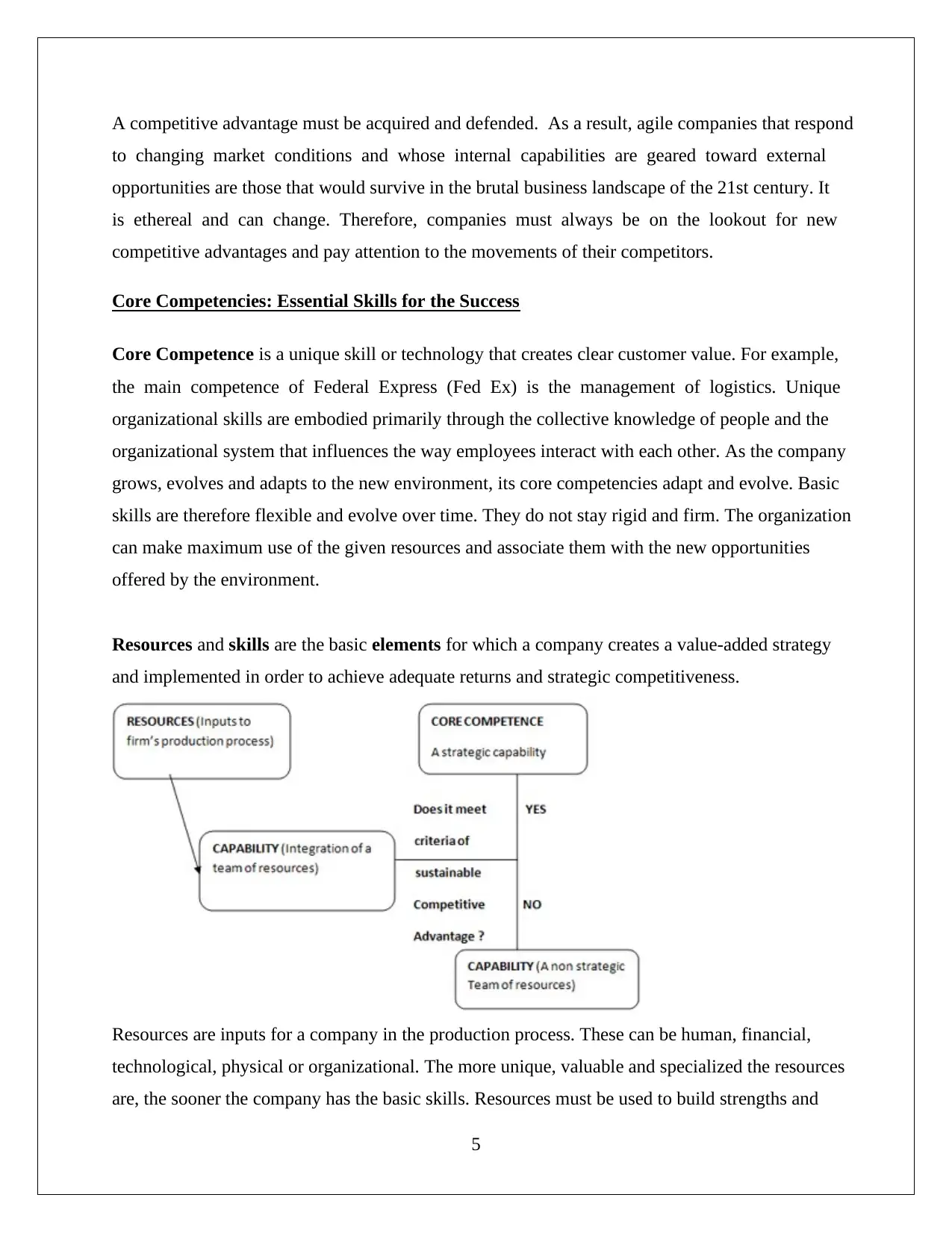
5
A competitive advantage must be acquired and defended. As a result, agile companies that respond
to changing market conditions and whose internal capabilities are geared toward external
opportunities are those that would survive in the brutal business landscape of the 21st century. It
is ethereal and can change. Therefore, companies must always be on the lookout for new
competitive advantages and pay attention to the movements of their competitors.
Core Competencies: Essential Skills for the Success
Core Competence is a unique skill or technology that creates clear customer value. For example,
the main competence of Federal Express (Fed Ex) is the management of logistics. Unique
organizational skills are embodied primarily through the collective knowledge of people and the
organizational system that influences the way employees interact with each other. As the company
grows, evolves and adapts to the new environment, its core competencies adapt and evolve. Basic
skills are therefore flexible and evolve over time. They do not stay rigid and firm. The organization
can make maximum use of the given resources and associate them with the new opportunities
offered by the environment.
Resources and skills are the basic elements for which a company creates a value-added strategy
and implemented in order to achieve adequate returns and strategic competitiveness.
Resources are inputs for a company in the production process. These can be human, financial,
technological, physical or organizational. The more unique, valuable and specialized the resources
are, the sooner the company has the basic skills. Resources must be used to build strengths and
A competitive advantage must be acquired and defended. As a result, agile companies that respond
to changing market conditions and whose internal capabilities are geared toward external
opportunities are those that would survive in the brutal business landscape of the 21st century. It
is ethereal and can change. Therefore, companies must always be on the lookout for new
competitive advantages and pay attention to the movements of their competitors.
Core Competencies: Essential Skills for the Success
Core Competence is a unique skill or technology that creates clear customer value. For example,
the main competence of Federal Express (Fed Ex) is the management of logistics. Unique
organizational skills are embodied primarily through the collective knowledge of people and the
organizational system that influences the way employees interact with each other. As the company
grows, evolves and adapts to the new environment, its core competencies adapt and evolve. Basic
skills are therefore flexible and evolve over time. They do not stay rigid and firm. The organization
can make maximum use of the given resources and associate them with the new opportunities
offered by the environment.
Resources and skills are the basic elements for which a company creates a value-added strategy
and implemented in order to achieve adequate returns and strategic competitiveness.
Resources are inputs for a company in the production process. These can be human, financial,
technological, physical or organizational. The more unique, valuable and specialized the resources
are, the sooner the company has the basic skills. Resources must be used to build strengths and
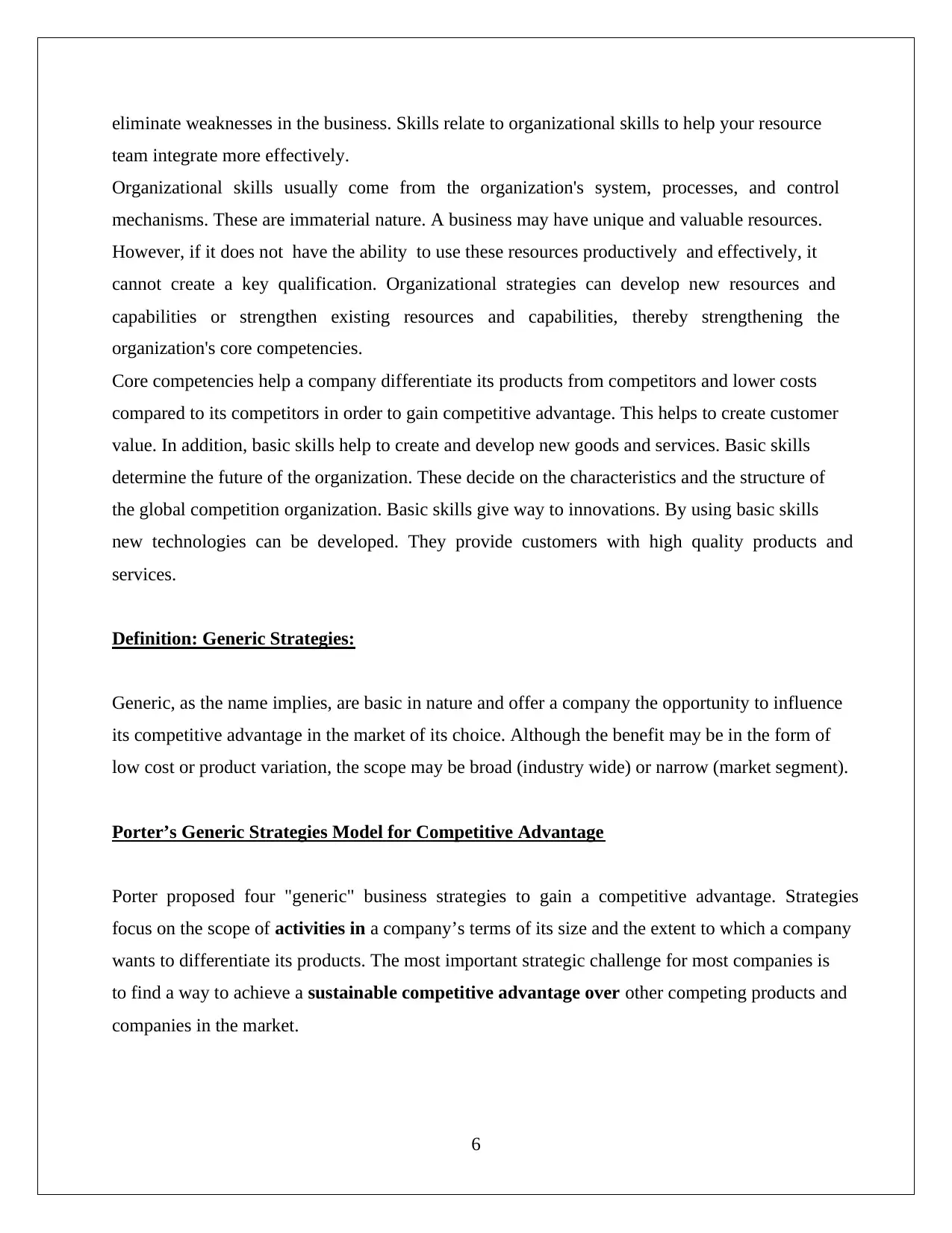
6
eliminate weaknesses in the business. Skills relate to organizational skills to help your resource
team integrate more effectively.
Organizational skills usually come from the organization's system, processes, and control
mechanisms. These are immaterial nature. A business may have unique and valuable resources.
However, if it does not have the ability to use these resources productively and effectively, it
cannot create a key qualification. Organizational strategies can develop new resources and
capabilities or strengthen existing resources and capabilities, thereby strengthening the
organization's core competencies.
Core competencies help a company differentiate its products from competitors and lower costs
compared to its competitors in order to gain competitive advantage. This helps to create customer
value. In addition, basic skills help to create and develop new goods and services. Basic skills
determine the future of the organization. These decide on the characteristics and the structure of
the global competition organization. Basic skills give way to innovations. By using basic skills
new technologies can be developed. They provide customers with high quality products and
services.
Definition: Generic Strategies:
Generic, as the name implies, are basic in nature and offer a company the opportunity to influence
its competitive advantage in the market of its choice. Although the benefit may be in the form of
low cost or product variation, the scope may be broad (industry wide) or narrow (market segment).
Porter’s Generic Strategies Model for Competitive Advantage
Porter proposed four "generic" business strategies to gain a competitive advantage. Strategies
focus on the scope of activities in a company’s terms of its size and the extent to which a company
wants to differentiate its products. The most important strategic challenge for most companies is
to find a way to achieve a sustainable competitive advantage over other competing products and
companies in the market.
eliminate weaknesses in the business. Skills relate to organizational skills to help your resource
team integrate more effectively.
Organizational skills usually come from the organization's system, processes, and control
mechanisms. These are immaterial nature. A business may have unique and valuable resources.
However, if it does not have the ability to use these resources productively and effectively, it
cannot create a key qualification. Organizational strategies can develop new resources and
capabilities or strengthen existing resources and capabilities, thereby strengthening the
organization's core competencies.
Core competencies help a company differentiate its products from competitors and lower costs
compared to its competitors in order to gain competitive advantage. This helps to create customer
value. In addition, basic skills help to create and develop new goods and services. Basic skills
determine the future of the organization. These decide on the characteristics and the structure of
the global competition organization. Basic skills give way to innovations. By using basic skills
new technologies can be developed. They provide customers with high quality products and
services.
Definition: Generic Strategies:
Generic, as the name implies, are basic in nature and offer a company the opportunity to influence
its competitive advantage in the market of its choice. Although the benefit may be in the form of
low cost or product variation, the scope may be broad (industry wide) or narrow (market segment).
Porter’s Generic Strategies Model for Competitive Advantage
Porter proposed four "generic" business strategies to gain a competitive advantage. Strategies
focus on the scope of activities in a company’s terms of its size and the extent to which a company
wants to differentiate its products. The most important strategic challenge for most companies is
to find a way to achieve a sustainable competitive advantage over other competing products and
companies in the market.
⊘ This is a preview!⊘
Do you want full access?
Subscribe today to unlock all pages.

Trusted by 1+ million students worldwide
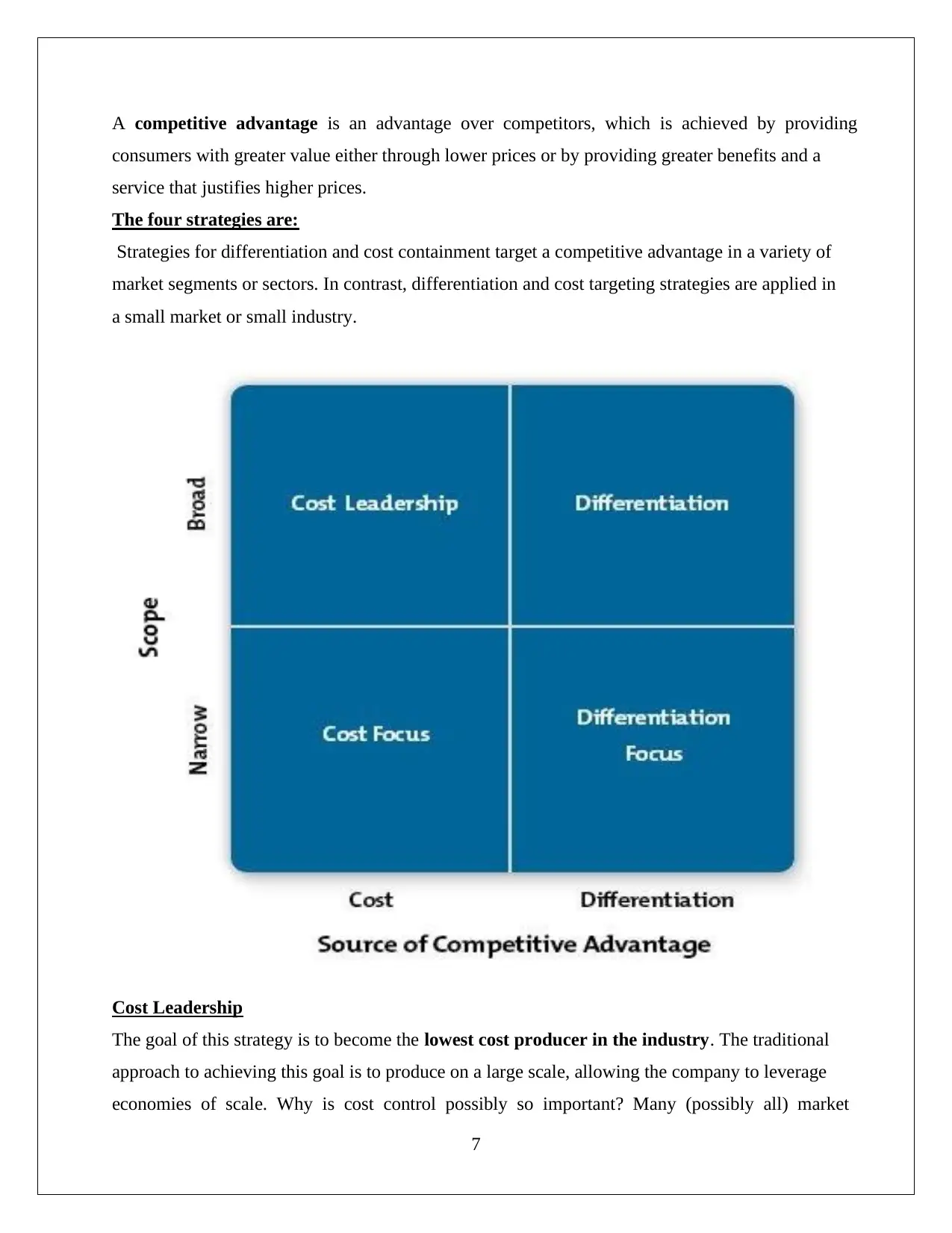
7
A competitive advantage is an advantage over competitors, which is achieved by providing
consumers with greater value either through lower prices or by providing greater benefits and a
service that justifies higher prices.
The four strategies are:
Strategies for differentiation and cost containment target a competitive advantage in a variety of
market segments or sectors. In contrast, differentiation and cost targeting strategies are applied in
a small market or small industry.
Cost Leadership
The goal of this strategy is to become the lowest cost producer in the industry. The traditional
approach to achieving this goal is to produce on a large scale, allowing the company to leverage
economies of scale. Why is cost control possibly so important? Many (possibly all) market
A competitive advantage is an advantage over competitors, which is achieved by providing
consumers with greater value either through lower prices or by providing greater benefits and a
service that justifies higher prices.
The four strategies are:
Strategies for differentiation and cost containment target a competitive advantage in a variety of
market segments or sectors. In contrast, differentiation and cost targeting strategies are applied in
a small market or small industry.
Cost Leadership
The goal of this strategy is to become the lowest cost producer in the industry. The traditional
approach to achieving this goal is to produce on a large scale, allowing the company to leverage
economies of scale. Why is cost control possibly so important? Many (possibly all) market
Paraphrase This Document
Need a fresh take? Get an instant paraphrase of this document with our AI Paraphraser
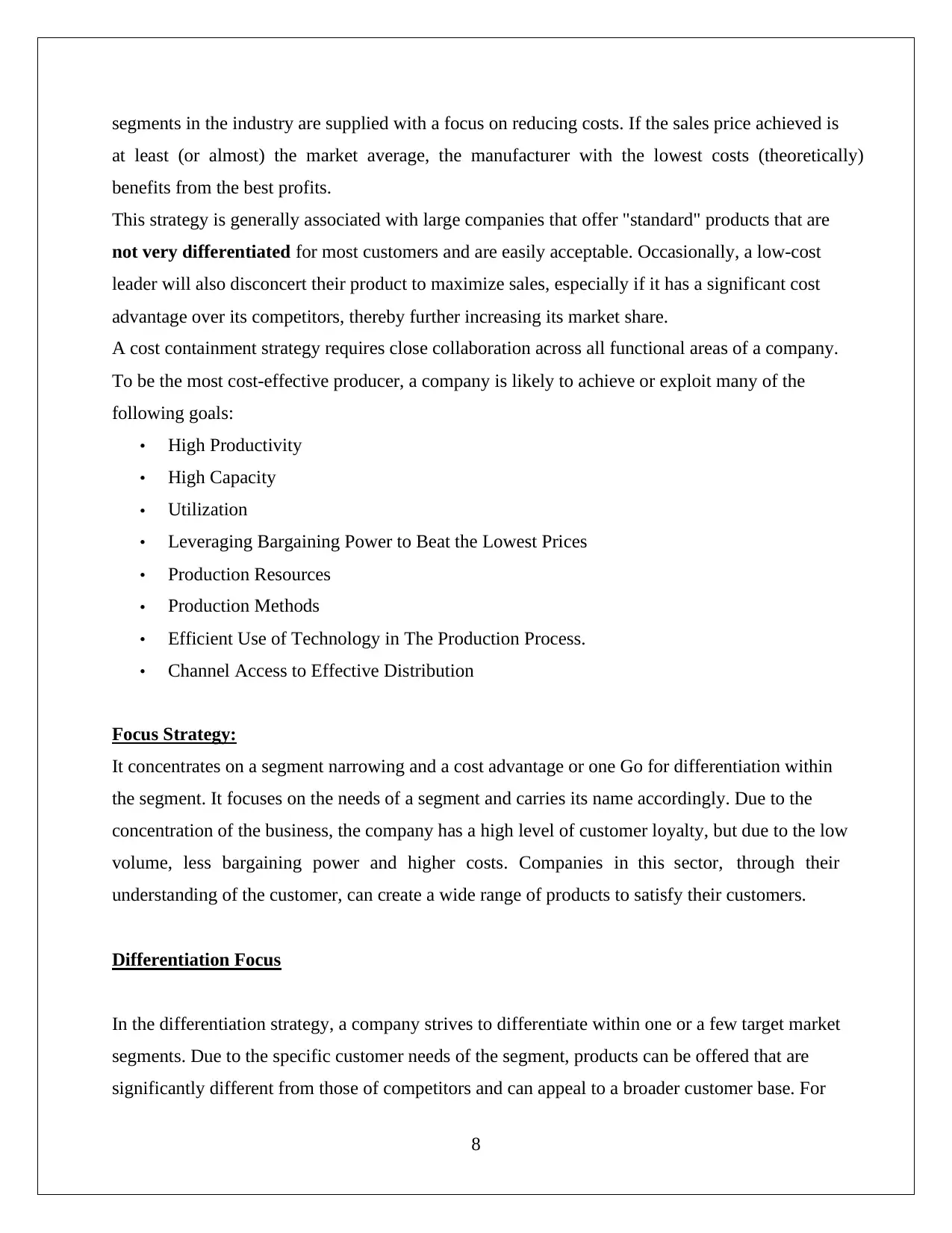
8
segments in the industry are supplied with a focus on reducing costs. If the sales price achieved is
at least (or almost) the market average, the manufacturer with the lowest costs (theoretically)
benefits from the best profits.
This strategy is generally associated with large companies that offer "standard" products that are
not very differentiated for most customers and are easily acceptable. Occasionally, a low-cost
leader will also disconcert their product to maximize sales, especially if it has a significant cost
advantage over its competitors, thereby further increasing its market share.
A cost containment strategy requires close collaboration across all functional areas of a company.
To be the most cost-effective producer, a company is likely to achieve or exploit many of the
following goals:
• High Productivity
• High Capacity
• Utilization
• Leveraging Bargaining Power to Beat the Lowest Prices
• Production Resources
• Production Methods
• Efficient Use of Technology in The Production Process.
• Channel Access to Effective Distribution
Focus Strategy:
It concentrates on a segment narrowing and a cost advantage or one Go for differentiation within
the segment. It focuses on the needs of a segment and carries its name accordingly. Due to the
concentration of the business, the company has a high level of customer loyalty, but due to the low
volume, less bargaining power and higher costs. Companies in this sector, through their
understanding of the customer, can create a wide range of products to satisfy their customers.
Differentiation Focus
In the differentiation strategy, a company strives to differentiate within one or a few target market
segments. Due to the specific customer needs of the segment, products can be offered that are
significantly different from those of competitors and can appeal to a broader customer base. For
segments in the industry are supplied with a focus on reducing costs. If the sales price achieved is
at least (or almost) the market average, the manufacturer with the lowest costs (theoretically)
benefits from the best profits.
This strategy is generally associated with large companies that offer "standard" products that are
not very differentiated for most customers and are easily acceptable. Occasionally, a low-cost
leader will also disconcert their product to maximize sales, especially if it has a significant cost
advantage over its competitors, thereby further increasing its market share.
A cost containment strategy requires close collaboration across all functional areas of a company.
To be the most cost-effective producer, a company is likely to achieve or exploit many of the
following goals:
• High Productivity
• High Capacity
• Utilization
• Leveraging Bargaining Power to Beat the Lowest Prices
• Production Resources
• Production Methods
• Efficient Use of Technology in The Production Process.
• Channel Access to Effective Distribution
Focus Strategy:
It concentrates on a segment narrowing and a cost advantage or one Go for differentiation within
the segment. It focuses on the needs of a segment and carries its name accordingly. Due to the
concentration of the business, the company has a high level of customer loyalty, but due to the low
volume, less bargaining power and higher costs. Companies in this sector, through their
understanding of the customer, can create a wide range of products to satisfy their customers.
Differentiation Focus
In the differentiation strategy, a company strives to differentiate within one or a few target market
segments. Due to the specific customer needs of the segment, products can be offered that are
significantly different from those of competitors and can appeal to a broader customer base. For
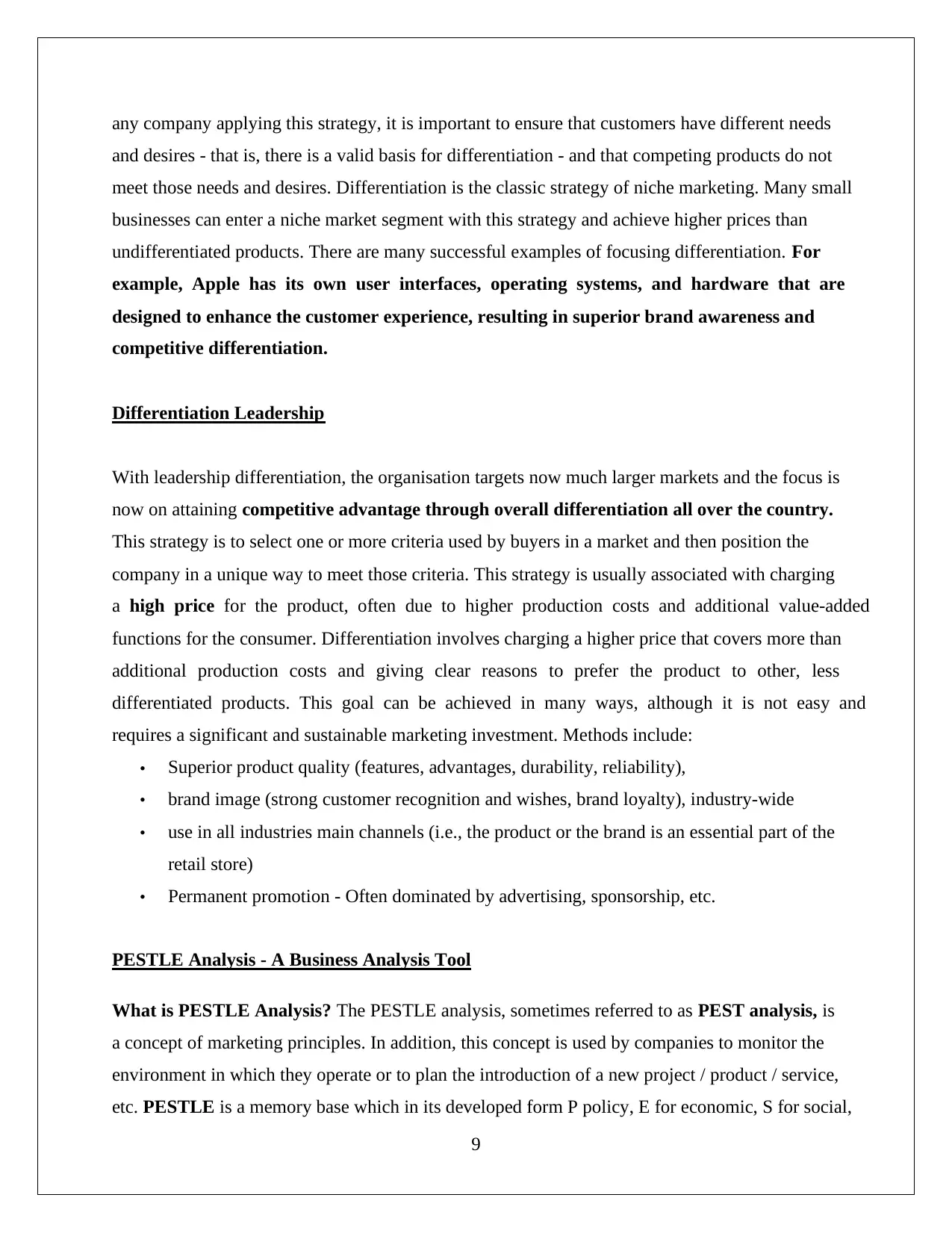
9
any company applying this strategy, it is important to ensure that customers have different needs
and desires - that is, there is a valid basis for differentiation - and that competing products do not
meet those needs and desires. Differentiation is the classic strategy of niche marketing. Many small
businesses can enter a niche market segment with this strategy and achieve higher prices than
undifferentiated products. There are many successful examples of focusing differentiation. For
example, Apple has its own user interfaces, operating systems, and hardware that are
designed to enhance the customer experience, resulting in superior brand awareness and
competitive differentiation.
Differentiation Leadership
With leadership differentiation, the organisation targets now much larger markets and the focus is
now on attaining competitive advantage through overall differentiation all over the country.
This strategy is to select one or more criteria used by buyers in a market and then position the
company in a unique way to meet those criteria. This strategy is usually associated with charging
a high price for the product, often due to higher production costs and additional value-added
functions for the consumer. Differentiation involves charging a higher price that covers more than
additional production costs and giving clear reasons to prefer the product to other, less
differentiated products. This goal can be achieved in many ways, although it is not easy and
requires a significant and sustainable marketing investment. Methods include:
• Superior product quality (features, advantages, durability, reliability),
• brand image (strong customer recognition and wishes, brand loyalty), industry-wide
• use in all industries main channels (i.e., the product or the brand is an essential part of the
retail store)
• Permanent promotion - Often dominated by advertising, sponsorship, etc.
PESTLE Analysis - A Business Analysis Tool
What is PESTLE Analysis? The PESTLE analysis, sometimes referred to as PEST analysis, is
a concept of marketing principles. In addition, this concept is used by companies to monitor the
environment in which they operate or to plan the introduction of a new project / product / service,
etc. PESTLE is a memory base which in its developed form P policy, E for economic, S for social,
any company applying this strategy, it is important to ensure that customers have different needs
and desires - that is, there is a valid basis for differentiation - and that competing products do not
meet those needs and desires. Differentiation is the classic strategy of niche marketing. Many small
businesses can enter a niche market segment with this strategy and achieve higher prices than
undifferentiated products. There are many successful examples of focusing differentiation. For
example, Apple has its own user interfaces, operating systems, and hardware that are
designed to enhance the customer experience, resulting in superior brand awareness and
competitive differentiation.
Differentiation Leadership
With leadership differentiation, the organisation targets now much larger markets and the focus is
now on attaining competitive advantage through overall differentiation all over the country.
This strategy is to select one or more criteria used by buyers in a market and then position the
company in a unique way to meet those criteria. This strategy is usually associated with charging
a high price for the product, often due to higher production costs and additional value-added
functions for the consumer. Differentiation involves charging a higher price that covers more than
additional production costs and giving clear reasons to prefer the product to other, less
differentiated products. This goal can be achieved in many ways, although it is not easy and
requires a significant and sustainable marketing investment. Methods include:
• Superior product quality (features, advantages, durability, reliability),
• brand image (strong customer recognition and wishes, brand loyalty), industry-wide
• use in all industries main channels (i.e., the product or the brand is an essential part of the
retail store)
• Permanent promotion - Often dominated by advertising, sponsorship, etc.
PESTLE Analysis - A Business Analysis Tool
What is PESTLE Analysis? The PESTLE analysis, sometimes referred to as PEST analysis, is
a concept of marketing principles. In addition, this concept is used by companies to monitor the
environment in which they operate or to plan the introduction of a new project / product / service,
etc. PESTLE is a memory base which in its developed form P policy, E for economic, S for social,
⊘ This is a preview!⊘
Do you want full access?
Subscribe today to unlock all pages.

Trusted by 1+ million students worldwide
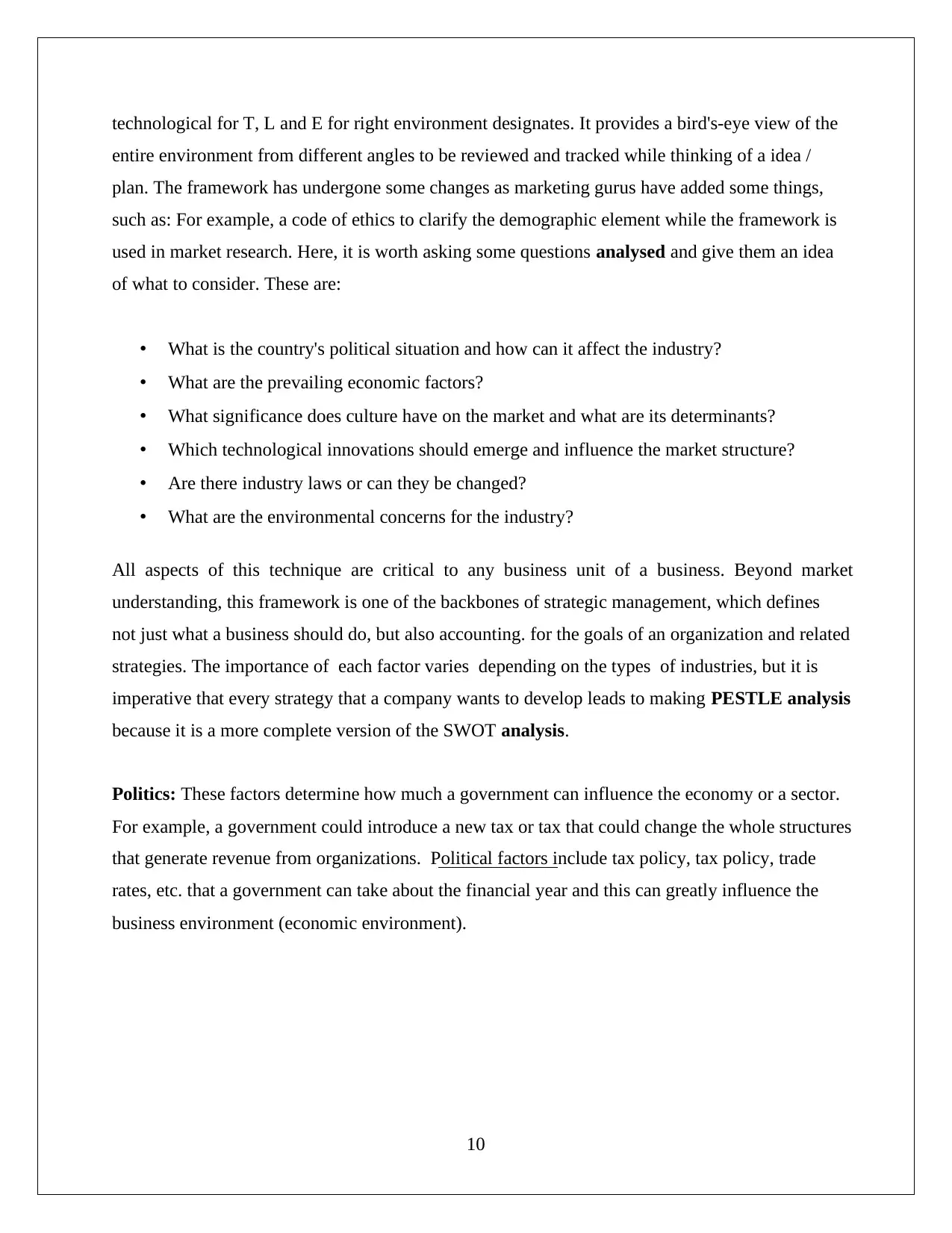
10
technological for T, L and E for right environment designates. It provides a bird's-eye view of the
entire environment from different angles to be reviewed and tracked while thinking of a idea /
plan. The framework has undergone some changes as marketing gurus have added some things,
such as: For example, a code of ethics to clarify the demographic element while the framework is
used in market research. Here, it is worth asking some questions analysed and give them an idea
of what to consider. These are:
• What is the country's political situation and how can it affect the industry?
• What are the prevailing economic factors?
• What significance does culture have on the market and what are its determinants?
• Which technological innovations should emerge and influence the market structure?
• Are there industry laws or can they be changed?
• What are the environmental concerns for the industry?
All aspects of this technique are critical to any business unit of a business. Beyond market
understanding, this framework is one of the backbones of strategic management, which defines
not just what a business should do, but also accounting. for the goals of an organization and related
strategies. The importance of each factor varies depending on the types of industries, but it is
imperative that every strategy that a company wants to develop leads to making PESTLE analysis
because it is a more complete version of the SWOT analysis.
Politics: These factors determine how much a government can influence the economy or a sector.
For example, a government could introduce a new tax or tax that could change the whole structures
that generate revenue from organizations. Political factors include tax policy, tax policy, trade
rates, etc. that a government can take about the financial year and this can greatly influence the
business environment (economic environment).
technological for T, L and E for right environment designates. It provides a bird's-eye view of the
entire environment from different angles to be reviewed and tracked while thinking of a idea /
plan. The framework has undergone some changes as marketing gurus have added some things,
such as: For example, a code of ethics to clarify the demographic element while the framework is
used in market research. Here, it is worth asking some questions analysed and give them an idea
of what to consider. These are:
• What is the country's political situation and how can it affect the industry?
• What are the prevailing economic factors?
• What significance does culture have on the market and what are its determinants?
• Which technological innovations should emerge and influence the market structure?
• Are there industry laws or can they be changed?
• What are the environmental concerns for the industry?
All aspects of this technique are critical to any business unit of a business. Beyond market
understanding, this framework is one of the backbones of strategic management, which defines
not just what a business should do, but also accounting. for the goals of an organization and related
strategies. The importance of each factor varies depending on the types of industries, but it is
imperative that every strategy that a company wants to develop leads to making PESTLE analysis
because it is a more complete version of the SWOT analysis.
Politics: These factors determine how much a government can influence the economy or a sector.
For example, a government could introduce a new tax or tax that could change the whole structures
that generate revenue from organizations. Political factors include tax policy, tax policy, trade
rates, etc. that a government can take about the financial year and this can greatly influence the
business environment (economic environment).
Paraphrase This Document
Need a fresh take? Get an instant paraphrase of this document with our AI Paraphraser
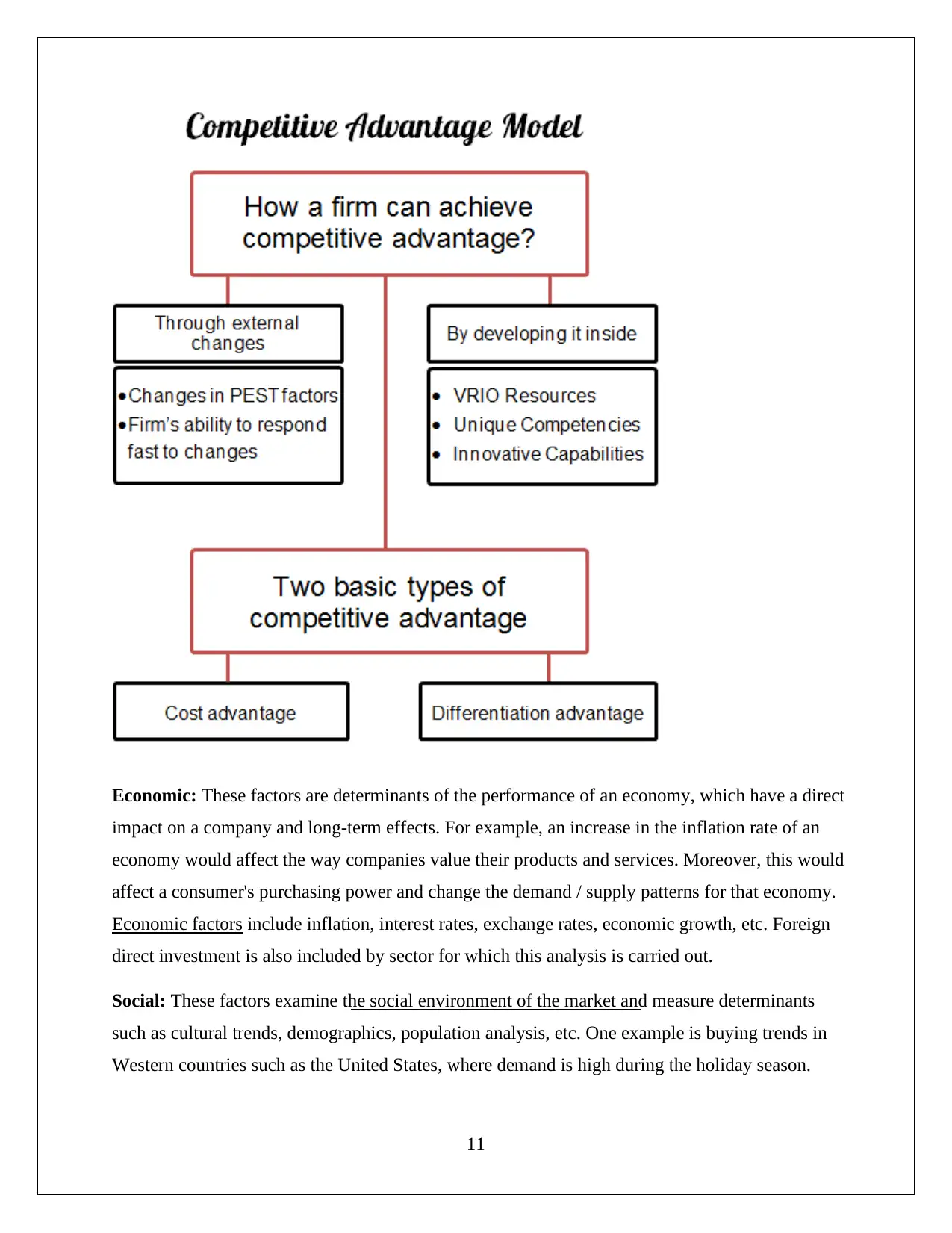
11
Economic: These factors are determinants of the performance of an economy, which have a direct
impact on a company and long-term effects. For example, an increase in the inflation rate of an
economy would affect the way companies value their products and services. Moreover, this would
affect a consumer's purchasing power and change the demand / supply patterns for that economy.
Economic factors include inflation, interest rates, exchange rates, economic growth, etc. Foreign
direct investment is also included by sector for which this analysis is carried out.
Social: These factors examine the social environment of the market and measure determinants
such as cultural trends, demographics, population analysis, etc. One example is buying trends in
Western countries such as the United States, where demand is high during the holiday season.
Economic: These factors are determinants of the performance of an economy, which have a direct
impact on a company and long-term effects. For example, an increase in the inflation rate of an
economy would affect the way companies value their products and services. Moreover, this would
affect a consumer's purchasing power and change the demand / supply patterns for that economy.
Economic factors include inflation, interest rates, exchange rates, economic growth, etc. Foreign
direct investment is also included by sector for which this analysis is carried out.
Social: These factors examine the social environment of the market and measure determinants
such as cultural trends, demographics, population analysis, etc. One example is buying trends in
Western countries such as the United States, where demand is high during the holiday season.
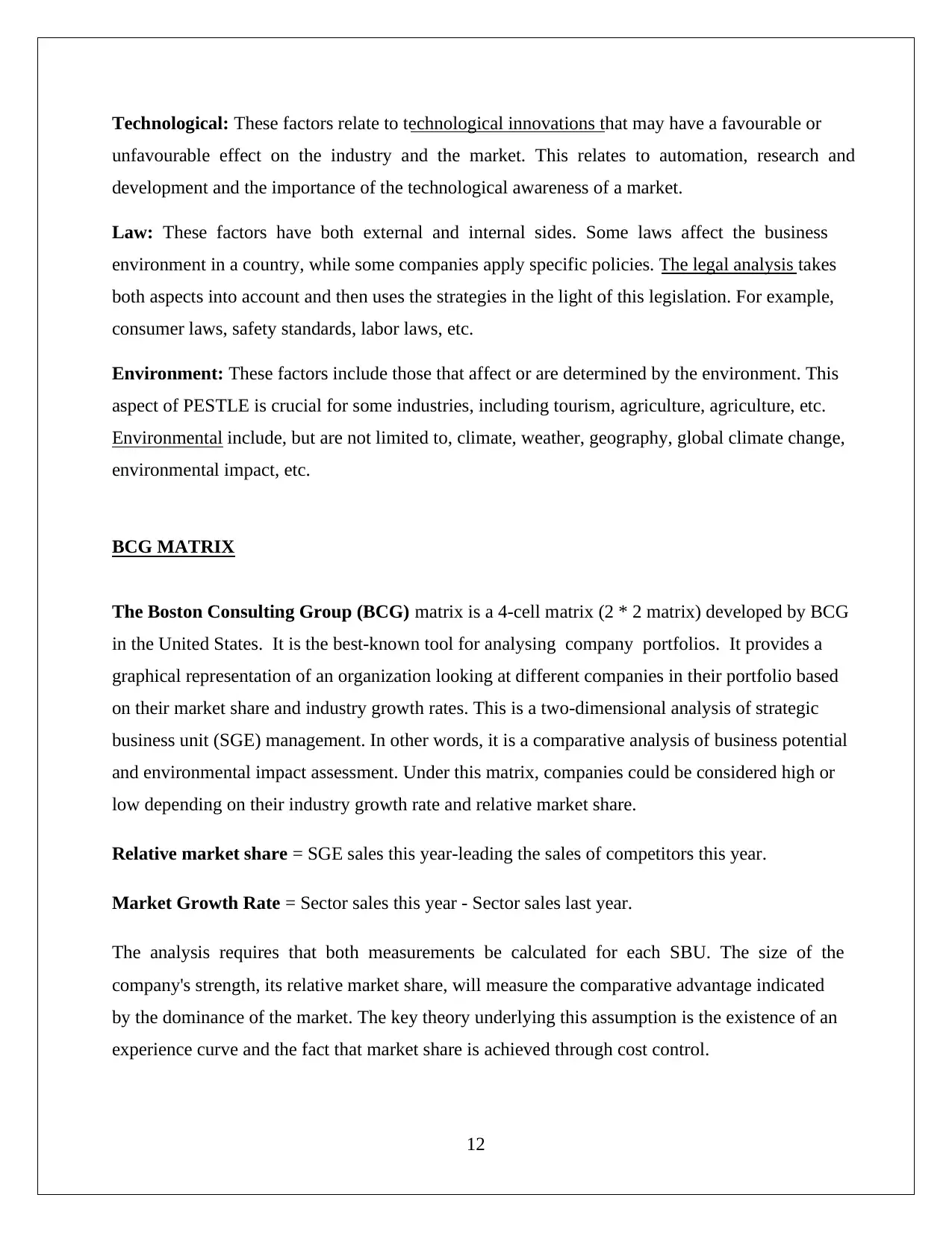
12
Technological: These factors relate to technological innovations that may have a favourable or
unfavourable effect on the industry and the market. This relates to automation, research and
development and the importance of the technological awareness of a market.
Law: These factors have both external and internal sides. Some laws affect the business
environment in a country, while some companies apply specific policies. The legal analysis takes
both aspects into account and then uses the strategies in the light of this legislation. For example,
consumer laws, safety standards, labor laws, etc.
Environment: These factors include those that affect or are determined by the environment. This
aspect of PESTLE is crucial for some industries, including tourism, agriculture, agriculture, etc.
Environmental include, but are not limited to, climate, weather, geography, global climate change,
environmental impact, etc.
BCG MATRIX
The Boston Consulting Group (BCG) matrix is a 4-cell matrix (2 * 2 matrix) developed by BCG
in the United States. It is the best-known tool for analysing company portfolios. It provides a
graphical representation of an organization looking at different companies in their portfolio based
on their market share and industry growth rates. This is a two-dimensional analysis of strategic
business unit (SGE) management. In other words, it is a comparative analysis of business potential
and environmental impact assessment. Under this matrix, companies could be considered high or
low depending on their industry growth rate and relative market share.
Relative market share = SGE sales this year-leading the sales of competitors this year.
Market Growth Rate = Sector sales this year - Sector sales last year.
The analysis requires that both measurements be calculated for each SBU. The size of the
company's strength, its relative market share, will measure the comparative advantage indicated
by the dominance of the market. The key theory underlying this assumption is the existence of an
experience curve and the fact that market share is achieved through cost control.
Technological: These factors relate to technological innovations that may have a favourable or
unfavourable effect on the industry and the market. This relates to automation, research and
development and the importance of the technological awareness of a market.
Law: These factors have both external and internal sides. Some laws affect the business
environment in a country, while some companies apply specific policies. The legal analysis takes
both aspects into account and then uses the strategies in the light of this legislation. For example,
consumer laws, safety standards, labor laws, etc.
Environment: These factors include those that affect or are determined by the environment. This
aspect of PESTLE is crucial for some industries, including tourism, agriculture, agriculture, etc.
Environmental include, but are not limited to, climate, weather, geography, global climate change,
environmental impact, etc.
BCG MATRIX
The Boston Consulting Group (BCG) matrix is a 4-cell matrix (2 * 2 matrix) developed by BCG
in the United States. It is the best-known tool for analysing company portfolios. It provides a
graphical representation of an organization looking at different companies in their portfolio based
on their market share and industry growth rates. This is a two-dimensional analysis of strategic
business unit (SGE) management. In other words, it is a comparative analysis of business potential
and environmental impact assessment. Under this matrix, companies could be considered high or
low depending on their industry growth rate and relative market share.
Relative market share = SGE sales this year-leading the sales of competitors this year.
Market Growth Rate = Sector sales this year - Sector sales last year.
The analysis requires that both measurements be calculated for each SBU. The size of the
company's strength, its relative market share, will measure the comparative advantage indicated
by the dominance of the market. The key theory underlying this assumption is the existence of an
experience curve and the fact that market share is achieved through cost control.
⊘ This is a preview!⊘
Do you want full access?
Subscribe today to unlock all pages.

Trusted by 1+ million students worldwide
1 out of 76
Related Documents
Your All-in-One AI-Powered Toolkit for Academic Success.
+13062052269
info@desklib.com
Available 24*7 on WhatsApp / Email
![[object Object]](/_next/static/media/star-bottom.7253800d.svg)
Unlock your academic potential
Copyright © 2020–2025 A2Z Services. All Rights Reserved. Developed and managed by ZUCOL.



